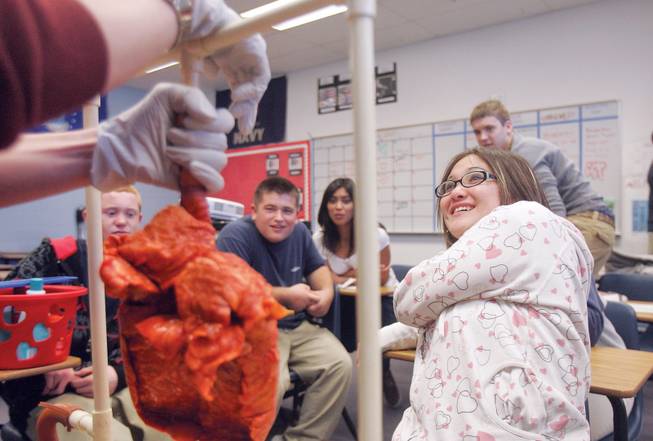
Channy Loughmiller flinches as a healthy human lung is held up during a presentation on how smoking can effect the ability to breath. Loughmiller is part of a group of students from Liberty High School that are being trained by the American Lung Association to give an interactive presentation to elementary-age students on why it’s important to avoid tobacco.
Tuesday, Feb. 3, 2009 | 2:28 p.m.
Related story
A simultaneous "Ewww" escaped the lips of the group of grimacing students as a pair of human lungs — blackened and spotted with tumors — were set up for display on the desk at the front of the classroom.
The lungs came to be shrunken, discolored and cancer ridden as the result of supporting a smoking habit of a pack a day for 15 years, said American Lung Association Tobacco Education Coordinator Courtney Swenson.
As the Liberty High School's U.S. Air Force Jr. Reserve Officers' Training Corps students looked on, Swenson pointed out the tissue that had died as a result of smoking and talked about everything else the students will need to know when their turn comes to present the material.
In the spring, the 13 students will carry out the American Lung Association's program Teens Against Tobacco Use (or TATU) in which they will visit nearby elementary schools and conduct an interactive presentation educating fourth and fifth graders about the dangers of tobacco use.
Swenson's visit to the school Thursday was to prepare them to host the presentations themselves.
Among the other tools from her anti-smoking arsenal that will soon be used by the Liberty students were two jars.
One was full of a thick, black, and gooey representation of the amount of tar accumulated in the lungs after smoking a half pack of cigarettes every day for a year, and the other full of a couple cups of a greenish sludge representing the amount of tar-infused mucous expelled by the lungs of a heavy smoker in a two-week period.
Senior Alejandro Paulino, who has done the elementary school presentations the last two years, said the youth are usually pretty receptive to the props used in the presentation and that he thinks he and his peers are reaching out to the right age group.
"If they know when they get to middle school what they might get themselves into, it helps," he said.
Sophomore Zac Selken agreed.
"If you get them at a younger age, to give them the message, it's more likely they won't smoke," he said.
In the latest report available, the American Lung Association reported that nationally 9.5 percent of middle school students used some form of tobacco in 2006.
While Alejandro and Zac are serving as role models to the younger generations in the Silverado area, other students at high schools across the district will also soon reach out to the youth in their areas.
Swenson said pretty much every high school in the district has been a part of Teens Against Tobacco Use at one time or another.
Recently, the far-reaching program got a little unexpected help in the form of a $150,000 grant from the Anthem Blue Cross and the Blue Shield Foundation.
"It was a major surprise," Swenson said.
It was especially appreciated considering the possibility of budget cuts because of the state's financial woes, she said.
The usual main sources of funding for the program come from grants given by the state and from money paid to the state as the result of lawsuits brought against major tobacco companies in 1998, she said.
The settlements required that the tobacco companies make annual payments to the state to compensate for tobacco-related health care costs.
In addition to the Teens Against Tobacco Use program, the money is also used to fund a second program sponsored by the American Lung Association, Not on Tobacco, which aims to help teen smokers quit.
The cessation program puts teens together with trained faculty who teach them the best tips and strategies to quit the habit.
Swenson said there are currently no high schools in the district participating in the Not on Tobacco program.
Ashley Livingston can be reached at 990-8925 or [email protected].


Join the Discussion:
Check this out for a full explanation of our conversion to the LiveFyre commenting system and instructions on how to sign up for an account.
Full comments policy